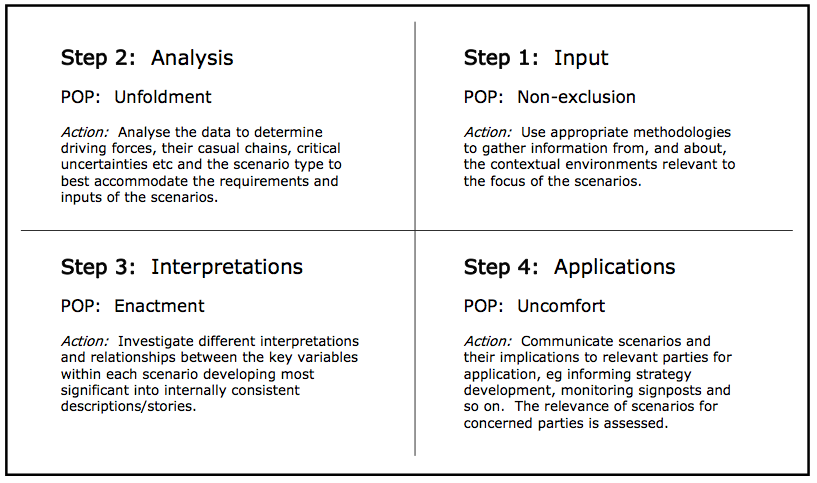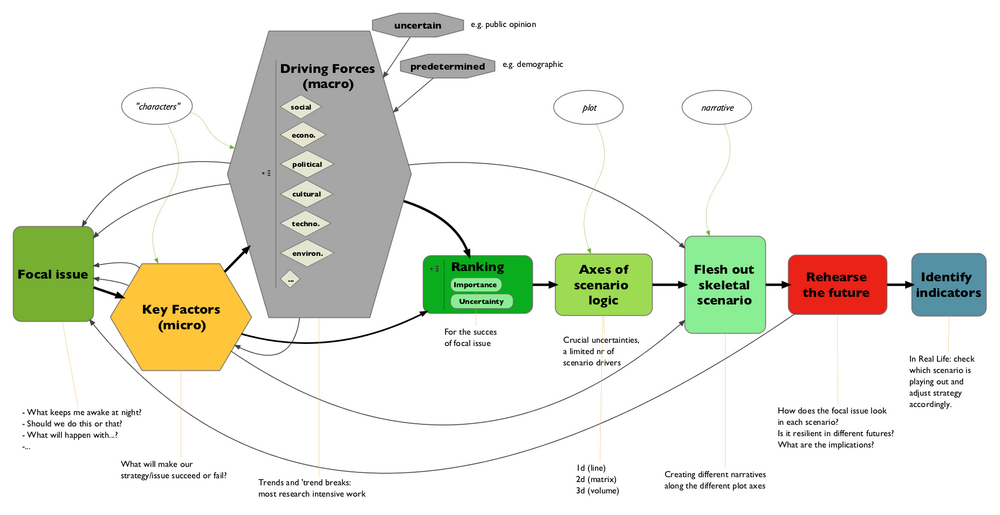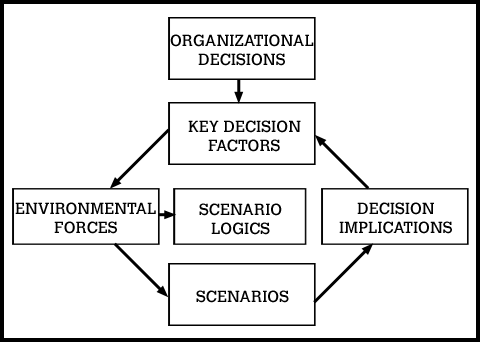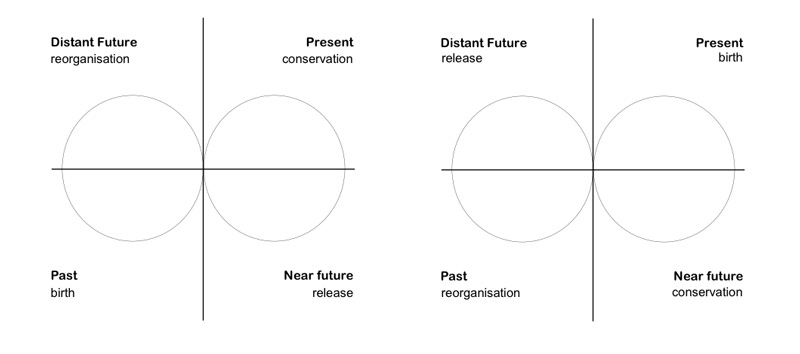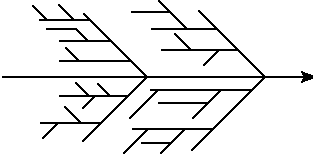Future Fabulators
Table of Contents
Scenario Methods
This page is an evolving, non-exhaustive collection of different methods and techniques that can be used in scenario building, particularly focusing on the ones that might be useful for Future Fabulators. There are many academic papers and consultants' websites describing a myriad of approaches to “how to build scenarios”. Though possibly oversimplifying the issue, we could say that for Future Fabulators the most important difference between methods is whether the scenarios are designed to be exploratory (multiple alternative scenarios for different possible futures), or normative (designing a desired scenario, then figuring out what needs to be done in order to get there). When working with normative scenarios the most interesting work is that of 'backcasting' or 'retrocasting' as we prefer to call it (see chapter below). With exploratory scenarios much time is spent on identifying constants and variables of a situation, that make up the scenarios (as characters, events, plot-lines…). These scenario components are derived from the key factors in the wider context of an issue (e.g. from the internal and external envrionment, past and present conditions), as well as the 'drivers of change' (micro and macro forces that influence change in a community, organisation or system).
An overview of scenario methods for strategy
Most scenario methods revolve around approximately similar phases:
- 1) delineating the space/issue/question
- 2) identifying elements of the scenario (factors, drivers, trends, measures, actors, events…)
- 3) selecting a reasonable amount of elements and creating a 'scenario logic'
- 4) combining (forecasting, projecting, extrapolating, visioning…) the elements into (different) scenarios and
- 5) using scenarios to (re)design decisions, strategies and actions in the present.
Or, as Chris Stewart proposes: Input, Analysis, Interpretation and Application
Figure from Integral Scenario Development by Chris C Steward
There are many possible answers to the question “how to build scenarios”. We won't attempt to collect them all on this page. As a filter in our research we decided to look at approaches that can help us move from forecasting to embodiment, from story to experience. In Future Fabulators we are primarily focused on creating (immersive) situations where possible futures / parallel histories or presents can be physically experienced (and then reflecting on how this experience can affect our present behaviours). Therefore for FFab it isn't extremely important to have the most accurate representation of past, present and possible futures. We are more curious to uncover conscious and unconscious assumptions that the participants might have about their lives and environments and seeing how these assumptions shape and distort their images of the future. The scenario process uses these assumptions as raw materials in creating storyworlds. During the scenario process our awareness of assumptions grows through non-judgmental observation and several waves of analysis and synthesis. On this page we review existing scenario building methods to make available a wide palette of methods to apply and customise for different groups with whom we co-create scenarios.
The most rewarding moment in scenario building (in our experience) is when participants begin to recognise different scenarios as extreme versions or caricatures of their present, as if they have acquired a mysterious search-light, that can be used to illuminate different parts of an otherwise murky, entangled situation. By using appropriate scenario methods, we hope to amplify these moments of clarity that spark imagination and a pro-active engagement with the futures. We're also interested how to make the whole process more fluid, creative and mindful (of self, others and the environment).
Methodology, though, is about more than the tools used: it involves careful attention to the stance taken by the practitioner in the use of tools to enact knowledge and understanding.“ -Floyd, Burns and Ramos1)
Methods, comparisons
A simple description of a scenario building process can be found in How to Build Scenarios by Lawrence Wilkinson. An counter-prespective can be found in Ten Rules for Creating Awful Scenarios by Jamais Cascio, which provides a checklist of what NOT to do when creating scenarios.
The paper to review all the techniques for developing scenarios that have appeared in the literature, along with comments on their utility, strengths and weaknesses. (…) Based on our review of the literature, we have discovered eight general categories (types) of scenario techniques with two to three variations for each type, resulting in more than two dozen techniques overall. There are, of course, variations of the variations.”
From The current state of scenario development by Peter Bishop, Andy Hines and Terry Collins, Foresight, Vol. 9(1)
Another attempt at scenario typology by Lena Börjeson and her colleagues classifies scenarios into three categories and six types:
They categorise scenario techniques (all of which contribute to different scenario methods) into three kinds:
From: Towards a user's guide to scenarios by Lena Börjeson et al
Using four different scenario building methods: the 2×2 matrix approach; causal layered analysis; the Manoa approach; and the scenario archetypes approach. (…) This exploratory comparison confirmed that different scenario generation methods yield not only different narratives and insights, but qualitatively different participant experiences. (…) There is little in the literature which attempts to evaluate the different types of futures insight which emerge when different scenarios methods are used, the way in which choice of method might influence the types of conversations which are enabled by different scenarios processes, or the benefits and risks in using one approach over another. (…) To some extent, any scenario method can be completed as a desk-top research exercise. But creating scenario processes that effectively create change means creating participatory processes: scenarios create new behaviour only insofar as they create new patterns of thinking across a significant population within an organisation. So how engaging is each method, and what kind of thinking, conversation, and energy does each method produce in participants? Each of these scenario methods appears to have distinguishing strengths. The 2×2 matrix approach produces four scenarios consistently focused on alternative outcomes for an issue at a specific scale. CLA generates conversations that dig down into the worldviews, mental models and cultural structures that inform how we perceive both issues and possible future outcomes. Manoa creates a diverse array of details across all levels of a possible future. Scenario archetypes guarantee consideration of outcomes across a specified set of worldviews. Yet none by itself is really a 'perfect', all-purpose approach. These differences underline the need for people who commission futures work to understand clearly what they are trying to achieve through scenario building, and to remain open to the methods that are most likely to be effective in reaching the desired outcome. (…) The primary lesson we have learned from this exercise as active practitioners is the value of mash-ups: combining and layering different techniques to enrich outcomes.“
From: Curry, Andrew and Wendy Schultz (2009), Roads Less Travelled in the Journal of Futures Studies, Vol. 13(4)
Examples of (historical) scenario methods:
2x2 Double Uncertainty
The scenario building exercise (step 1-6) in the prehearsal pocket guide is based on the 2×2 method by Peter Schwartz in The Art of the Long View. On this page Schwartz summarises the scenario building steps.
Causal Layered Analysis
Causal layered analysis is offered as a new futures research method. Its utility is not in predicting the future but in creating transformative spaces for the creation of alternative futures. Causal layered analysis consists of four levels: the litany, social causes, discourse/worldview and myth/metaphor. The challenge is to conduct research that moves up and down these layers of analysis and thus is inclusive of different ways of knowing.
Sohail Inayatullah in CLA: poststructuralism as method and the CLA Reader
CLA simplified:
- define the issue (or question)
- discuss each layer separately
- cluster into themes
- after reaching the bottom layer, pick a different myth/narrative and create a scenario by moving up the other layers, up to the new events and behaviours in 'litany'
Image Credit: Thinking Futures
The Manoa Approach
The Manoa approach “assumes that actual futures are generated by the turbulent intersection of multiple trends, and the interplay of their cascading impacts. Thus each Manoa scenario requires a base of at least three orthogonal drivers of change, preferably emerging issues or 'weak signals.' The design is best suited to creating scenarios 25+ years out, maximally different from the present: it aims to produce surprising scenarios that shake current working assumptions/ (…) Five steps:
[1] choose 3-5 significant emerging issues of change ('weak signals');
[2] brainstorm or mindmap the potential impact cascades of each, working one by one;
[3] consider the cross-impacts arising from the 3-5 drivers and their impacts working together;
[4] doublecheck the depth of detail using an ethnographic inventory;
[5] develop a summary metaphor or title
Four Generic Futures
Our use of “alternative futures” (or “scenarios”) is usually within the context of helping an organization or community plan for and move towards its preferred future. (…) I have chosen to explain our use of alternative futures as though I were telling an interested community or organization what the components of a futures visioning process are in our understanding and experience, and how to conduct the various parts of an overall futures visioning process.
James Dator in Alternative Futures at the Manoa School
Dator discusses the process of creating four generic futures (Continue, Collapse, Discipline and Transform) - as four types of stories in which all/most future scenarios can be classified:
1) Continue: What are the ways in which the system in which we find ourselves could continue as it is?
2) Collapse: What are the ways in which it could fall apart?
3) Discipline: What are the ways in which it could be directed?
4) Transform: What are the ways in which it could change altogether?
Phrased this way, each generic image of the future presents a challenge to test the boundaries of one’s expectations and understanding of the system.
From Stuart Candy in his disertation The Futures of Everyday Life
For more details see four generic futures
Cone of Plausibility
The Cone of Plausibility, according to Charles W. Taylor, “serves as an enclosure that circumscribes the thought process of the players. The strength of their thought process to build these scenarios and to hold them together as they proceed outward in time is a counterforce to the pressures of wild cards to disrupt the cone. Scenarios within the cone are considered plausible if they adhere to a logical progression of trends, events, and consequences from today to a predetermined time in the future”
Morphological Analysis / FAR
Morphological Analysis is a way to create one normative scenario, from which a number of critical uncertainties are selected and given a set of variables; by combining different variables several 'worlds' can be created, as stepping stones for a smaller set of branching scenario timelines. See also Field Anomaly Relaxation.
Other methods
Joseph Coates wrote “Today the question of what scenarios are is unclear except with regard to one point-they have become extremely popular. Many people see scenarios as forecasts of some future condition while others disavow that their scenarios are forecasts. Yet looking at scenarios that do not come labeled as forecasts or non-forecasts. It is difficult to tell them apart. The purpose of the scenario is at a meta level, since the scenario usually does not speak for itself in terms of its purpose.” More in Scenario Planning. Another early in depth overview of How Companies Use Scenarios was written by Mandel and Wilson.
Michel Godet writes in The Art of Scenarios and Strategic Planning: “we strive to give simple tools that may be appropriated. However, these simple tools are inspired by intellectual rigor that enables one to ask the right questions. Of course, these tools do not come with a guarantee. The natural talent,common sense, and intuition of the futurist also count!”
Anna Maria Orru and David Relan wrote The Scenario Symphony for the Resilients project, containing a whole range of scenario creation methods and techniques, including the dynamic panarchy and temporal model. It's interesting to compare it to the “Four Generic Futures” method above.
Integral Scenario Development by C.C. Stewart is based on the holistic integral theory of Ken Wilber and integral futures of Richard Slaughter.
More methods are described in the Futures Research Methodologies chapter 13 by Jerome C. Glenn and The Futures Group International.
Finally, an interesting avenue to explore are remote scenario planning workshops using various online collaboration tools. Jamais Cascio describes here how he conducted a virtual scenario workshop, Noah Raford describes another experiment in online scenario planning.
Scenario Techniques
Below we explore different techniques/elements of scenario building based on the 2×2 uncertainty method, a method that we have used in the first months of Future Fabulators' workshops. The structure of the document is based on our questions that emerged during process-debriefs. After compiling the questions, we investigated techniques that could help us improve the process.
Preparation beforehand
What can we/participants prepare for a scenario workshop beforehand?
Commonly the people organising the workshop will “Work on identifying major drivers, trends and events should be initiated ahead of the first workshop: this is an opportunity to draw on relevant horizon scanning work and other analysis. Ideally this work will be synthesised into a format which can be accessed easily by workshop participants, either as preparatory material or at the workshop itself. Material researched at this stage should include a mix of thematic material, together with analyses of broader trends.” The Horizon Scanning Centre (pdf)
other possibilities:
- Interviews, questionnaires for participants beforehand
- Collective horizon scanning (facilitators, participants)
- Insight meditation
- Collecting relevant news clippings, images and articles by all participants
What are the ideal settings (e.g. room size per person) for a scenario workshop?
from our experience:
- a large, long smooth wall or white/blackboard (at least 4-5 metres long, longer is better)
- enough space for all participants to sit comfortably in a circle or semicircle
- additional space for 3-5 breakout groups (a large working table, chairs, a wall or another surface to hang stuff up
- social space with comfortable seating (e.g. sofas, bean bags, cushions) & refreshments (if possible for the whole group, otherwise for at least 4-5 people)
- empty space (at least 3x3m for spreading stuff out, or doing physical/spatial sessions)
- big windows with natural light
- facilitation table (with various materials)
- 'library' or books, media, magazines, images… related to the topics discussed
- easy access to outdoor spaces
- …
Key question
How to craft good questions?
- The art of powerful questions: an excellent insight into the 'questioncraft', essential reading for any process facilitator
How to better structure/encourage designing the core question?
Questions encourage an inquiring mind
Why does it seem more difficult to phrase questions rather than stating problems?
“In nearly all cases it should be possible to formulate the purpose of the scenarios work as a question. If this proves difficult, this is often an indication that the work will not be taken up when completed, even if it is of a good quality.” -The Horizon Scanning Centre (pdf)
Plotting past and present
What are different ways to map-out the past and present situation surrounding the key question?
- 6 root questions (identify variables), 2 holarchy questions (link variables), different POP questions (check variables) from integral scenario development:
- (Subject of focus): When? Who/What? + (Actors and factors relating to the subject of focus): Who? Why? What/How? Where?
- Who is internal to X (organisation, community, project)? What is the X internal to? - this might help in clustering and structuring the map of the context
- 'Have we sought out as many relevant perspectives as possible?'
- 'Have we actively sought to identify (surface, objectify) the perspectives/mental models we have used in each stage of the process?' 'How might our perspectives effect what we have identified?' 'Are there others we haven't included?' 'Why not?'
- 'Have we identified relationships among the different variables identified?' 'Are there other evolutionary sequences and casual chains (vertical and horizontal relationships) that might link and summarise these variables?' 'How might these sequences be meta-linked?'
When to use this step?
When can it be reduced/removed? When is it more important to focus on this step (observe, then interact as permaculture teaches us) than to work on possible future scenarios?
In very short workshops when participants know each other well, perhaps, but it might be better to always include at least a few minutes of it, to allow participant's to see differences in perception of the same situation.
What does a 'futurism without prediction' look like?
A few ideas on non_predictive_strategy
When does it help to talk about things that are fixed, or constraints that exist?
- in a workshop where the group had a pressing need to resolve a situation, talking about what is fixed quickly gave a picture of what was still possible to change and what was the space in which the group could move to find solutions to a blockage
- on the other hand, in more open-ended workshops (say in the beginning of projects) talking about what's fixed created some discomfort (or perhaps it was just unclear what we meant by fixed)
Key factors
What are different ways to visualise and cluster the relationships between key factors
- Force Field Analysis by Kurt Lewin, where the key question is placed in the middle, forces exerting pressure for the change on the left, and against the change on the right.
- “interrogate anomalies: data or incidents that seem anomalous - that somehow “don’t fit”, seem weird or don’t make sense, should receive immediate attention. They could be pointers to a shift in the system as a whole” From: http://silberzahnjones.com/2012/10/04/crafting-non-linear-strategy-the-nature-of-the-problem/#more-799
What do we mean by key factors?
- internal (local) variables
- success criteria (what will make my question succeed or fail)
Change Drivers & Weak Signals
- how much analysis is appropriate for the types of scenarios and prehearsals we’re making? best to decide on a case-by-case basis
- how can we make assumptions and guesswork more apparent (i.e. indicating how drivers can be based on an assumption, guess or 'fact')? see cognitive bias
- what is the relevance of facts and data related to drivers of change in experiential futurism? TBD
- can we have a more constructive discussion about the macro trends which results in something more meaningful than a list of assumptions (without too much expert analysis needed beforehand)? See Causal Layered Analysis, Manoa Approach, Field Anomaly Relaxation, horizon scanning
How do we look at drivers as dynamic forces? should we be looking at responses to trends rather than trends in general? (nouns → verbs)
- Trend Impact Analysis (quantitative)
- should we make our own STEEP (or similar) cards to avoid the 'business bias'? probably, if we have the time, perhaps something related to causal layered analysis or integral scenario development focus on long term trends only + add wild cards (random images/words/tarot/playing cards…).
- are there other well understood methods to group trends other than the customary STEEP (in which cultural changes seem to be clumped in with social or political)? see horizon scanning and Ethnographic Futures Framework
Is there another way to look at large scale changes aside from trends (without having to do a PhD in each of the changes)?
- weak signals, emerging issues, historical analogues
- the Manoa approach says looks at emerging issues rather than drivers of change - ref. needed…
How effective are these methods and how can we usefully evaluate them?
It seems to be a big (and unresolved) issue (see ”Foresight for Public Policy” thesis by Mihaela Ghisa)
Ranking critical uncertainties
(this is relevant primarily for the 2×2 uncertainty scenario method. other methods use more/less axes (but are equally vague about how to select them)
- what are different ways in which this is done by others? most approaches i could find use numbers, or conversation. therefore Tim Boykett's more relative and graphically represented formalised decision making is an interesting approach, that we have proven works well with different groups of people
- Morphological Analysis could be a great way to work with a large number of clustered drivers, that can be combined in different ways to select a smaller set of important and/or quickly create basic scenario skeletons. The foodprints ruler from FoAM Nordica works on a similar principle.
Scenarios
How to construct alternative future scenarios
From: The Horizon Scanning Centre (pdf)
And also:
- four generic futures by the Manoa School
- CLA: probing deeper cultural foundations of core issues
- Manoa approach: “the scenarios it produces are generally much longer-term, and far more divergent / transformative in their structure – for sophisticated clients only, or to enhance creativity and innovation in R&D and product design staff. The resulting scenarios also work well as provocations in incasting exercises” From http://www.infinitefutures.com/tools/sb.shtml
- Harman Fan: “thinking through the multiple causalities that produce an infinite array of alternative possible futures” http://www.infinitefutures.com/tools/sbharman.ppt
- etc (see in methods above)
How to better structure building scenario skeletons with guiding questions (which questions could be generalised)?
One suggestion (not sure about all of the focus on problems):
A. General discussion of your future
B. How probable (likely to actually occur) is the future described in your scenario? C. How preferable is the future described in your scenario? That is, how close is it to your own preferred future? D. To the extent the future described in your scenario is judged preferable by your group, what five things need to be done now to move towards those desirable aspects of that future? E. To the extent the future described in your scenario is judged undesirable by your group, what five things need to be done now to see that those undesirable aspects not occur?
From Alternative Futures at The Manoa School by Jim Dator
Other possibilities: An option from integral scenario development by Christ C Stewart is to Apply 6 root questions (relating to factors and actors) and the AQAL framework (four quadrants by Wilber) to deepen the scenario stories. Also, the layers from Causal Layered Analysis can be used as probes in fleshing out scenarios. Finally (something we haven't explored yet): the elements of the Ethnographic Futures Framework (Bowman & Schultz, 2005) might be useful.
From scenarios to story-worlds
- what techniques can we use to flesh out the scenarios into interesting stories?
- “a day in the life of…” (a character in a scenario, or one character in different scenarios)
- …
Retrocasting
Aka Backcasting is about searching for present signals, asking the question “how to get from here to there”. “Backcasting starts with defining a desirable future and then works backwards to identify policies and programs that will connect the future to the present.”
When we practice retrocasting/retrotesting or scenario testing (as coined in the http://www.ideo.com/work/method-cards/IDEO Method Cards) we don't exclusively look at a desirable future, but at different possible futures resulting from scenario building, in an attempt to identify signals in the present that might point to the future moving in this or that direction. This is perhaps similar to the work of Dator, Schulz and others related to the “four generic futures” (see above in scenario examples), known as deductive forecasting or incasting.
“The best kinds of stories are about how you get from here to there, not just what there looks like.” –Jamais Cascio
What tools can we use to structure scenario testing?
Cause & Effect Diagram: “The cause and effect diagram is used to explore all the potential or real causes (or inputs) that result in a single effect (or output). Causes are arranged according to their level of importance or detail, resulting in a depiction of relationships and hierarchy of events.” In scenario testing this could be used not as 'cause and effect', but how to get there from here (note down a topic from the scenario, then work backwards to see what would have to happen to make it happen).
Another interesting possibility is to abstract principles from a scenario and retrocast from them. In this article they suggest not to use scenarios at all, but to work from agreed upon sustainability principles.
Theory of change model is essentially backcasting for specific goals: http://www.theoryofchange.org/what-is-theory-of-change/
what are important things to focus on?
- (weak) signals
- dependencies and bottlenecks
- clear actions, policies, tactics
- …
Visualising
Which methods could we use to visualise scenarios?
- moodboards
- collages
- storyboard
- newspaper with headlines
- video mix
- https://en.wikipedia.org/wiki/Pinterest|pinterest board (or similar collective online pinboard)
Prototyping
- which methods could we use to prototype possible futures?
- rapid prototyping, fabbing
- paper, scissors and tape
- …
More on possible_futures_parallel_presents design fiction, guerrilla futures and experiential futures
Prehearsals
- how to design them?
- how to host them?
- how to evaluate them?
continue research on prehearsal methods
Follow-up
- How can we follow-up what happens to the groups after we finish the workshops (especially to understand what happens to commitments to actions and preferred possible futures)?
- How much do we need to be involved in the follow-up?
It all depends on the purpose of the workshop…
Futures research methods
From: Identifying systems' new initial conditions as influence points for the future
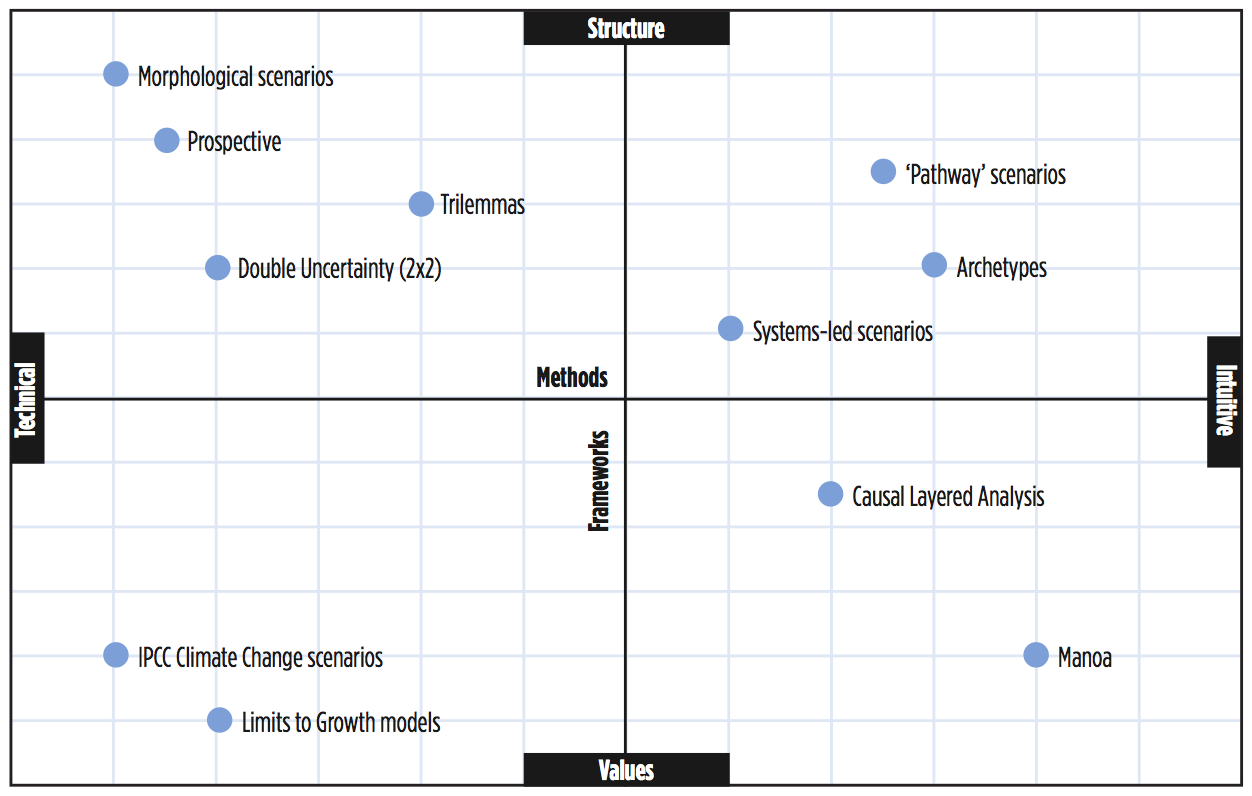
Mapping scenarios techniques. (Source: Andrew Curry)

